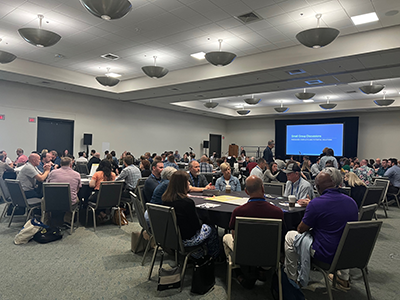It’s Not Necessarily Solar vs. Agriculture

When the topic of solar development comes up in rural communities, it is not uncommon for the first reaction to be fear that it will negatively impact agricultural activities. Residents and elected officials alike might assume that these two land uses are fundamentally at odds.
This is not necessarily the case; preserving agricultural activities (or identity) in a community and making space for large-scale solar facilities are not mutually exclusive goals. For solar development to be seen as a valid form of positive community change, planners, local officials, and solar developers will need to counter the narrative that agriculture and solar energy are inherently in conflict.
Mitigating Solar Development Impacts

Participants at the Solar@Scale learning lab share takeaways and insights about solar development and agriculture in small groups. Photo by Alexsandra Gomez
This was the focus of "Striking a Balance Between Solar Development and Agriculture," a recent Solar@Scale-sponsored learning lab at NPC22 in San Diego. During the session, participants worked in small groups to identify actual or perceived conflicts and then generate potential ways to eliminate or mitigate them.
Some of the common perceived or actual threats associated with solar development include unwanted aesthetic changes, loss of livelihoods or heritage, inequitable distribution of benefits, and negative ecological impacts. Fortunately, though, local officials or developers can often minimize or eliminate these threats through siting and project design decisions.
The first step should be education on what a community can reasonably request from solar developers. This knowledge can facilitate community buy-in early in the process and allow local officials to establish policies and developers to implement interventions that achieve the chosen co-benefits.
Blending Solar with Rural Landscapes
Residents of rural communities are often hesitant to have scenic views or general character disrupted by solar development. Potential solutions include appropriate landscaping and fencing that can blend solar facilities into the scenery. A community may also request that a developer invest in the preservation of forests or other natural features off-site. Residents can gain familiarity with the actual environmental impacts of a solar facility, instead of preconceived ideas of the level of noise and glare, by visiting existing sites.
Threats to local ecology can be just as important to residents as aesthetics. Developers can ease these concerns by integrating wildlife corridors, pollinator-friendly or native vegetation, and activities such as restorative soil management into their projects. They can also exhibit a genuine effort to repurpose previously developed sites, including capped landfills or other brownfields, before choosing to site near or on prime farmland.
The fear of losing traditional livelihoods or agricultural heritage is another common concern. But in many cases, small farms can become more viable with additional income from hosting solar facilities. Co-location of solar and agriculture, or agrivoltaics, is an increasingly feasible solution, such as combining grazing land or shade-grown crops with solar facilities. Another potential solution could be requiring developers to support agricultural activities in areas of the community that are not suitable for solar development. This can reduce competition for land while maintaining local agricultural heritage.
Addressing Local Opposition Concerns
And as with any form of new development, residents may be skeptical of the distribution of benefits. Solar development projects will have to demonstrate that they will provide clear benefits for existing residents — and that those benefits will be equitably distributed. They can also explicitly target benefits to residents that current and past development has underserved, thus resolving economic inequalities and building the local economy.
By being aware of the reasoning behind local opposition to solar development, planners and policymakers can assist in a "win-win" scenario where developers meet the needs of residents. Instead of ignoring these concerns, addressing the root of misconceptions is the first step to establishing a new narrative that agriculture and solar can exist side by side in a community.
Have a question about Solar@Scale or want to share your experiences with planning and zoning for large-scale solar development? Contact solar@planning.org.
Top image: Photo by Dennis Schroeder / NREL.


